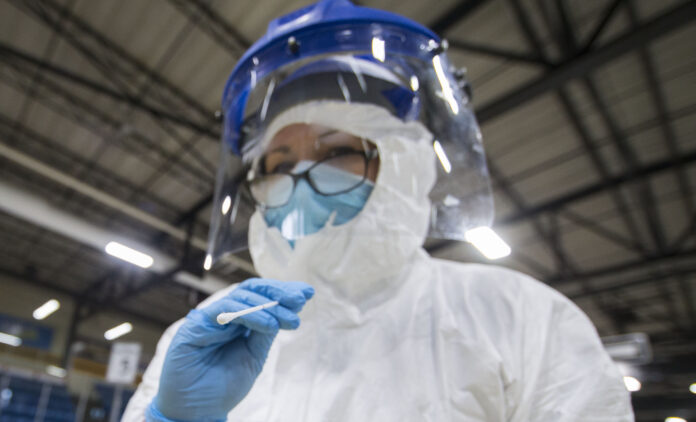Story continues below advertisement
However, as infections soar, patients with COVID in ICUs (intensive care units) have remained relatively stable but are overall on a slow rise. Experts have said it could take up to two weeks or more following a surge in new cases to see a sharper rise in hospitalizations/ICUs.
Of the 3,453 new cases recorded, the data showed 673 were unvaccinated people, 132 were partially vaccinated people, 2,500 were fully vaccinated people and for 148 people the vaccination status was unknown.
According to Tuesday’s report, 901 cases were recorded in Toronto, 359 in Ottawa, 345 in York Region, 280 in Peel Region, 245 in Halton Region, 168 in Waterloo and 160 in Durham Region. All other local public health units reported fewer than 160 new cases in the provincial report.
Deaths, vaccinations, recoveries, testing, 7-day average in Ontario
The death toll in the province has risen to 10,123 as 10 deaths were reported.
As of 8 p.m. on Monday, there are more than 11.3 million people fully immunized with two doses, which is 87.9 per cent of the aged 12 and older population. First dose coverage stands at 90.5 per cent. There are more than 2.1 million Ontarians who have received a booster shot.
For young children aged five to 11, first dose coverage stands at 38.3 per cent — 412,875 doses out of just over 1 million eligible children.
Story continues below advertisement
Meanwhile, 621,355 Ontario residents were reported to have recovered from COVID-19, which is 95 per cent of known cases. Resolved cases increased by 1,332 from the previous day.
Active cases in Ontario now stand at 25,702 — up from the previous day when it was at 23,591, and is up from Dec. 13 when it was at 12,032. At the peak of the second wave coronavirus surge in January, active cases hit just above 30,000. In the third wave in April, active cases topped 43,000.
The seven-day average has now reached 3,153, a months-long high since early May as Ontario emerged from a devastating third wave. This is up from the week prior when it was 1,400. A month ago, the seven-day average was around 650.
Trending Stories
Rapid COVID-19 tests: When to take one, and what to do if it’s positive
Toronto senior being deported after more than 20 years in Canada: ‘I belong here’
The government said 49,285 tests were processed in the previous 24 hours. There are 48,096 tests currently under investigation.
Test positivity hit 9.9 per cent meaning almost 1 in 10 tests are coming back positive for COVID — the highest seen since the end of April. Last week, test positivity was at 6.6 per cent.
Hospitalizations in Ontario
Ontario reported 412 people in general hospital wards with COVID-19 (up by 128 from the previous day) with 165 patients in intensive care units (up by one) and 153 patients in intensive care units on a ventilator (up by one).
Story continues below advertisement
Ontario Health officials have recently said intensive care occupancy can hit between 250 or 300 patients with COVID before the health care system would be impacted and require ramping down some non-urgent surgeries and procedures.
In the third wave peak, which was the worst wave for hospitalizations, the province saw as many as 900 patients in ICUs with COVID and almost 2,400 in general hospital wards.
For those in general hospital wards with COVID, 145 were unvaccinated, 12 were partially vaccinated and 109 were fully vaccinated. For those in ICUs, 89 were unvaccinated while 4 were partially vaccinated and 37 were fully vaccinated.
Provincial officials noted this new dataset with vaccination status for hospitalizations will grow and improve over time as more information is collected. There may also be a discrepancy due to how and when the information for both is collected.
Story continues below advertisement
Here is a breakdown of the total cases in Ontario by gender and age:
328,598 people are male — an increase of 1,747 cases.
326,204 people are female — an increase of 1,698 cases.
19,513 people are under the age of four — an increase of 113 cases.
40,648 people are 5 to 11 — an increase of 357 cases.
58,594 people are 12 to 19 — an increase of 373 cases.
245,388 people are 20 to 39 — an increase of 1,453 cases.
182,239 people are 40 to 59 — an increase of 870 cases.
83,544 people are 60 to 79 — an increase of 256 cases.
27,127 people are 80 and over — an increase of 34 cases.
The province notes that not all cases have a reported age or gender.
Here is a breakdown of the total deaths related to COVID-19 by age:
Deaths reported in ages 19 and under: Seven
Deaths reported in ages 20 to 39: 112
Deaths reported in ages 40 to 59: 719
Deaths reported in ages 60 to 79: 3,342
Deaths reported in ages 80 and older: 5,942
The province notes there may be a reporting delay for deaths and data
Cases, deaths and outbreaks in Ontario long-term care homes
According to the Ontario Ministry of Long-Term Care, there have been 3,831 deaths reported among residents and patients in long-term care homes across Ontario, which is unchanged since the previous day. Thirteen virus-related deaths in total have been reported among staff.
Story continues below advertisement
There are 19 current outbreaks in homes, which is up by two from the previous day.
The ministry also indicated there are currently 26 active cases among long-term care residents and 37 active cases among staff — up by one and up by four, respectively, in the last day.
Advertisement
© 2021 Global News, a division of Corus Entertainment Inc.



